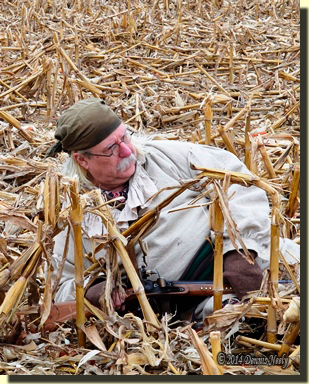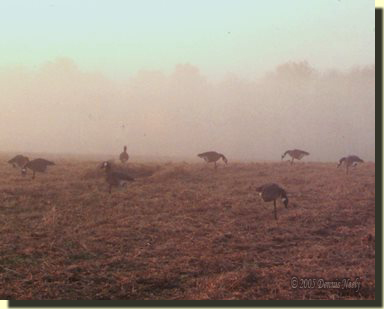Wet corn stubble perfumed still air. A full moon, white and mellow, high to the west, guided buffalo-hide moccasins through dawn’s first glimmer. The night prior, before the drizzle, forty-plus geese gathered on the cornfield’s eastern-most knob. They took flight an hour after dark, ke-honking as they winged to the River Raisin, deep in the Old Northwest Territory. “October 15, 1796” was scribbled at the top of that day’s journal entry, along with “maybe tomorrow?”
Sometimes, but not always, the geese would return an hour after dawn to their night feeding ground and land in the opposite end of the field; no rhyme nor reason, just years of frustrated observations from the wrong location. Moccasin footfalls progressed to the hilltop to the west. This was a gamble for sure, but one that might produce a roasted goose dinner. The thought induced instant salivation. At worst the woodsman would arise from the field damp, stiff and dirty.
Now on that clear morning, after the night-time shower, the hired post hunter carried an old blanket, dyed a drab brown with walnut hulls, torn on the one edge, soiled from past goose chases, yet rolled neat and cast over his shoulder. This was not an all-day hunt, rather a side excursion of whimsy and hope, a reason to travel light and easy.
With sweeping swipes the right moccasin scuffed tawny stalks and curled leaves into a hefty pile. Folded in half lengthwise, the blanket settled on the cleared ground. The woodsman sat in the center, checked the Northwest gun’s prime and rested it on the blanket to his right side. Sitting upright, he grabbed handfuls of fodder, placing them over his buckskin leggins and knee breeches. Stalks and leaves formed a headrest. Leaning back, his left arm tugged the remainder of the pile over his torso like the folly of a thread-bare quilt. His gaze faced west, in the direction of the River Raisin, relaxing and patient.

A southwest breeze arrived as yellow and lavender spears darted from the eastern horizon. The sweet aroma of drying corn filled his nostrils. With luck, black-necked geese might drift down with set wings, into the wind, right to left, passing over “Old Turkey Feather’s” anxious muzzle, rousting the death bees from peaceful slumber.
“Kee-honk, kee-honk, yonk, yonk…” A single Canada goose flew west to east. Its head with the white patch dipped earthward, surveyed the corn, but kept on flying.
“Caw, caw, caw, caw… Caw, caw, caw, caw…” Six crows came next, circling, banking and flapping upward with no possible direction, other than trying to instigate a raucous scene. Overcome with the silence that followed, the post hunter’s mind slipped away, not into sleep, but rather into a tranquil calm that seldom exists in the midst of a simple pursuit.
A robin chirped and a blue jay screamed. “The elk moccasins need attention,” he thought. “The tear in the tail of the linen shirt needs mending…new winter mittens…oh, the felling ax needs a good stoning…and…” Sandhill cranes, three to the south and two to the north, interrupted his backcountry “to-do” litany, “Urrr-ggooou-aaa, Urrr-ggooou-aaa…”
“Ke-honks” foretold of another pair of geese, again, in the air after spending the night on the river. Voices silenced a ways from the corn. The pair circled once and began their descent. To the south, a string of seven geese began honking. The lead bird’s long, black neck glanced sideways. Gentle wingbeats, mixed with a glide or tumble here and there, returned to steady thrusts as the pair pulled up, fifty yards distant, perhaps more. They angled in a southeasterly direction, parallel to the seven, but headed for another breakfast rendezvous.
A wedge of eleven appeared, with more to the west. Those birds stayed high, giving the woodsman’s cornfield hideout no mind. Twenty two, fifteen, then two loners followed. The stubble that was a goose’s delight the night before offered no promise…
To Decoy or Not to Decoy…
“Do you hunt with decoys?” is a question sometimes asked at the outdoor shows. The answer is a noncommittal, “Occasionally.” I usually turn to the photo albums and leaf through the pages looking for specific pictures. Each comes with a story, as one might surmise.
In the early years of my traditional black powder hunting affliction, decoys were not necessary. The tactic used on that October morning in 2008—find a feeding field at night and the geese will return in the morning—worked with better than average results for many years. Goose numbers were up and hunting pressure was minimal. Then the big obsession with goose hunting hit—trailer loads of decoys, layout blinds, and big diesel trucks to pull the whole shebang. Not to complain or criticize, rather observing the impact of modern techniques.
That October hunt was a turning point. A decision had to be made, stick with the old traditions or use a spread of decoys. I lose interest when modern game habits push the woodland scenario into the future. Those situations aren’t as much fun as cavorting with my hunter heroes on an 18th-century stage.
A few years back, when the section oak collapsed in June while I was at Friendship, I set out two dozen goose decoys bought at a garage sale. Birds looked, set their wings and landed just beyond their plastic brethren. I found myself trapped, hoping the incessant honking might bring a pair low over my cornstalk lair. Instead, a big wedge pulled the birds from their morning repast. At least I didn’t have to stand up and spook them.

My interpretation of that calamity was that today’s birds are now wary of landing “where they should” in a decoy spread. Six-inch plastic suppositories, charged with a pound of steel shot, capable of reaching a hundred yards, taught the survivors to social distance or die.
Recently I watched an outdoor show where a half-dozen hunters set up for geese. I was working on making deer-hair cones—modern versus traditional attitudes. When the banging started, I glanced at the flat screen. Now I realize the camera distorts distance, but those hunters were shooting at birds fifty yards up and out. I laughed, as it reminded me of a goose hunt years ago.
It’s a long story, but my brother-in-law, Dave, and I ended up on a guided goose hunt. Dave had never hunted geese before, and the guide, who was a customer of mine, wanted to introduce him to the sport free of charge.
Well, there was a mix up, and five other hunters showed up that morning. They had the wrong date for their paid hunt. The guide was in a bind, and considering his kindness in taking Dave hunting, I said it wasn’t a problem. They turned their nose up at the idiot standing there in moccasins, leather leggins, a drab-colored hunting shirt and a sweat-stained “dew rag,” leaning against a funny-looking “antique gun with a rock.” Thank you, gents, for the returned kindness.
The guide laid out the rules, emphasizing “I call the shot.” These hunters, decked out in the finest camo money could buy, armed with those big suppository guns and toting leather shoulder bags stuffed with ammo, took over the bench in the blind. The guide was upset.
I explained that I had to be on the right side, touch hole flash and all, and that Dave and I would weasel our way into the pile of spare brush left over from hiding a blind in the middle of cut corn.
Not long after, a nice wedge of a dozen geese circled, honking back at the guide’s beseeching. They swung wide and were headed to the hole in the decoys in front of the blind. The geese were dumping air about forty yards out when the first hunter jumped up and opened fire. “Stay down,” I told Dave as I put my hand on his arm. All five took three shots apiece. You could hear steel hit feathers and bounce off. Not a bird fell.
The guide came unglued. “I said ‘I’ll call the shot,’” he yelled. “If you jump my call again, you’re out of here.”
David’s eyes got big. “I’ve never heard a guide talk like that,” he whispered. Those geese would have dropped in twenty yards in front of us, I explained. A good shot for “Old Turkey Feathers,” a difficult shot for big guns with tight chokes.
Eight birds came in. The same fellow started to jump. His companion stopped him. “Let them get one shot off. The geese will flap to gain air and come right in front of us. You shoot for the first bird,” I whispered. Those birds followed the script. Dave knocked down the first goose with one shot, I took the third. Everyone else missed; too close for teensy-diameter shot strings. The guide couldn’t stifle his amusement with the performance of the antique gun with the rock.
For the surviving six birds, the wilderness classroom lesson that day was “don’t land in the middle of other geese,” especially the velvet-flocked ones with over-sized feet. And that continual conditioning makes it tough for a traditional woodsman with a cylinder-bored gas pipe.
Wild turkey hunting is getting just as bad. I passed on a flock of jakes early in the spring season, which turned out to be a egregious mistake. A bird with a two-inch beard walked seventeen paces from the ground-hugging juniper that I sat in. He was searching for the hen that clucked once a half hour earlier. I wanted a long-bearded gobbler, and they all hung up fifty yards out. Hmmm… that same fifty yard distance the big suppositories claim. Is there a correlation?
I have a nice hen decoy, Henrietta is her name. Late in the season she gets to come to the woods, when the gobblers are real call shy. She hasn’t attracted a suitor in several seasons. She’s getting to be an old maid. When not in the woods, she sits in the back seat of the pickup, staring over the console. That scares the daylights out people that approach the truck windows.
And I picked up several hen decoys at an estate sale over on Waterman Road a few years back. While I am confessing my decoy sins, I must say that I have set up a small herd of hens before, scattered, facing every direction, mimicking what I observed in the wild. But that tactic hasn’t worked, either. My experience matches that of my neighbors, so the linen and leather are not the problem.
My “to do list” includes fabricating a turkey decoy and maybe a couple of geese in the fashion of Native American decoys. Unfortunately, time is the prohibiting factor there. I have alter egos that need clothes and 18th-century trinkets. They are as needy as little kids…
Give traditional black powder hunting a try, be safe and may God bless you.


